“Making a perfect plate of spaghetti is not rocket science but there is a little science behind making it just right. Spaghetti is always considered an easy, quick dish to prepare, but it is amazing how many people get it wrong.”
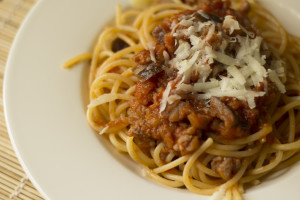
For quite some time now I have been asking you to be on the lookout for my newest eBook, The Science Behind Perfect Spaghetti – Gracie’s Pasta Guide. Well some things just seemed to take longer than expected, including coming up with the right title (still up in the air). The good news is that I expect to have this project wrapped up by the Eyes of March. Below is an excerpt, guiding you to a perfect bowl of Spaghetti.
From Chapter One, Section Two:
“An important thing to remember is that most dried pasta doubles in volume when cooked. You should always measure pasta by weight rather than by cup. A good rule of thumb is that one pound pasta will usually serve four (4) people.
How To Cook Perfect Spaghetti/Pasta:

Comparison between different types of long Italian pasta (Photo credit: Wikipedia)
Don’t cook the Spaghetti until you’re ready to eat – Spaghetti or any pasta cut should be served hot and is usually ready in about 8 minutes once your water is boiling. All side dishes and sauces should be just about done when you start boiling your spaghetti.
To cook pasta properly, you need a lot of water, so use a large pot. Too small a pot and too little water will cause the pasta to stick together and cook unevenly.
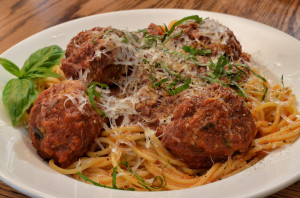
For a pound (16 ounces) of pasta, you will want a pot that holds at least 5 or 6 quarts of water. Use plenty of cold water, which helps prevent pasta from sticking together by quickly washing away the exuded starch.
Remember, hot water will dissolve anything (including contaminants like lead) if you have older lead pipes, it (lead) could very well end up in your pot. The more common problem is water that has been sitting in your home pipes for over 6 hours.
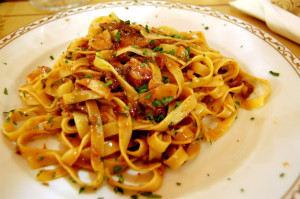
Fresh makes every pasta dish better
Cover the pot and bring to a boil. Covering will help the water to boil faster. Add salt, as this helps the pasta taste better and in releasing its natural flavors. I always wait to salt my water at the same time I add the pasta. Salt dissolves quicker in hot water and will not damage pots. I usually add about 2 tablespoons of kosher (coarse) salt per pound of pasta.
MYTH; Many people think that adding salt adds to the sodium level of the finished pasta. This is not true, so don’t hold back on the salt. You really want to get the pasta properly seasoned. In recent years I have been adding Sea Salt and do find I can get away with using less.
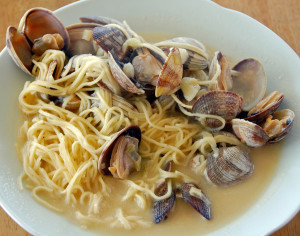
Like I said, just before I add the pasta is when I add my salt. Be certain to add the pasta all at once. Keep the heat high so the water returns to a boil. Lower heat if and when the water boils over.
I don’t think I can remember the water NOT boiling over when I was a kid. I can still hear my mom shouting at me from another room to lower the water. I’m sure she wanted this to happen, knowing that the water needed to stay hot.
WHY HOT: Pasta added to water before it boils begins to break down as the starch dissolves and will lead to a mushy product. The water temperature does drop once you add the pasta, which explains why mom always let the pasta water boil over.
After you add the pasta begin to stir with a long wooden spoon to prevent the pasta from sticking together or to the pot. It’s amazing how man people skip this step. Continue to stir the pasta during the entire cooking process.
The pasta should cook uncovered, and at a fast boil. I always cook my pasta to taste and never rely on the cooking directions printed on the side or back of the package. Pasta usually takes about 8 to 10 minutes but different shapes and textures all effect the cooking time.
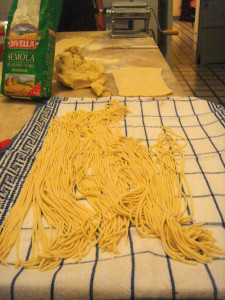 Fresh pasta laid out to dry.
Fresh pasta laid out to dry.
NOTE: Fresh pasta cooks up way faster than the dried stuff. Keep you eyes on fresh pasta and taste often. The finished pasta should be tender but still firm when you eat it, what we call “al dente.” Again be sure to taste the pasta for readiness, but watch out, your sample will be HOT! Like most foods, pasta will continue to cook after it has been taken from the water.
TIP: The best way to test for “al dente” is to remove a strain of spaghetti, cut it in half and look for just a speck of white inside. Any more than a speck and the pasta is not ready. If you don’t see any white the pasta is leaning towards being overcooked.
Drain your pasta immediately and shake it well to remove excess water. Do not rinse! I have seen this many times and never got a clear explanation why people do this. Rinsing will cause the pasta to lose starch which is vital in having your sauce adhere to the pasta. Have you ever seen watery pasta and sauce? Chances are the pasta was rinsed.
ASIDE – Now you can rinse the wide pasta, such as lasagna noodles or manicotti shells. If you don’t, you will have a hard time separating the noodles without tearing them and rinsing can make them easier to handle.

Linguine with porcini mushrooms
One thing I always watched my mom do with spaghetti or any long cut and that was to cut them in hail. I assumed it was because they fit in her pot better, but I suggest you stay away from this habit. The whole noodle just presents better. Use a Pasta Fork to push long cuts into your pot.
There you have it, the science of making perfect spaghetti/pasta. Stick to the basics and you will end up with the quick and easy dish spaghetti/pasta was meant to be.”
The Science Behind Perfect Spaghetti – Gracie’s Pasta Guide will be available soon, and many of the dishes you see pictured in this post will be featured. The book will also be added to our Gracie’s Cares program, so a percentage of the sales will be given to a worth charity. Be on the lookout!
Related articles

photos by:
&
,
,
,
,
McPig














Pingback: Bucatini - A Recipe | Gracie's Ravioli